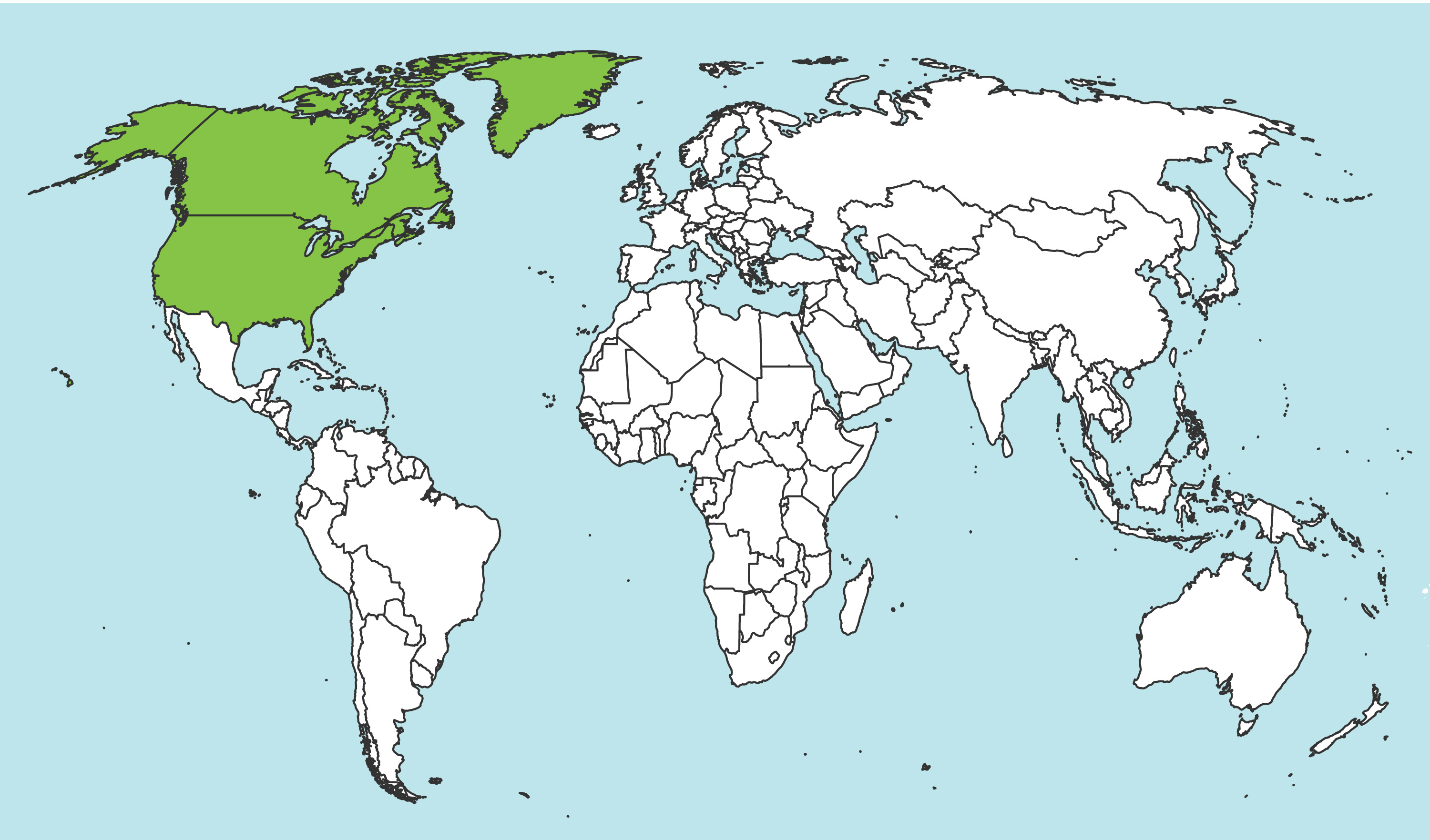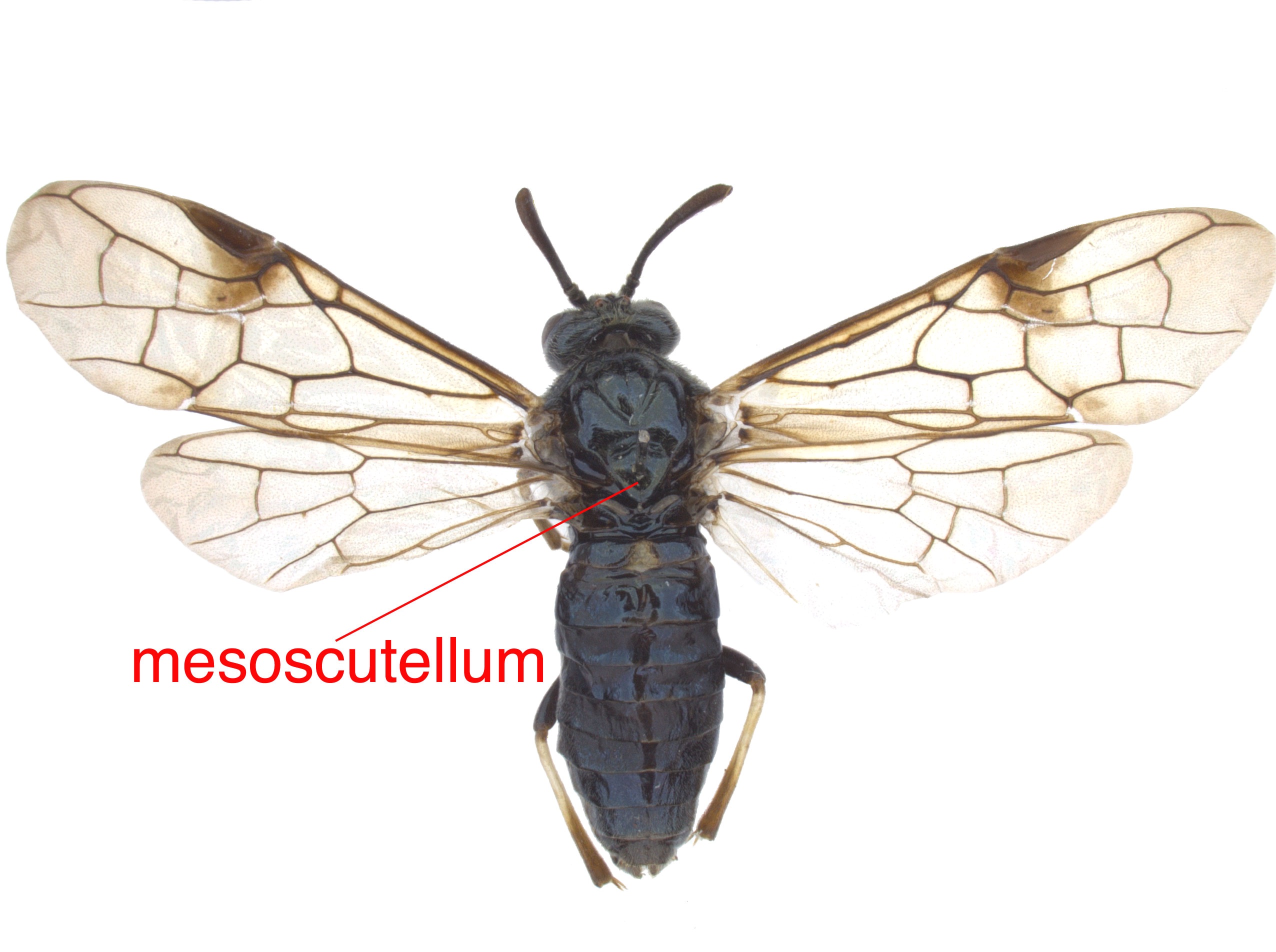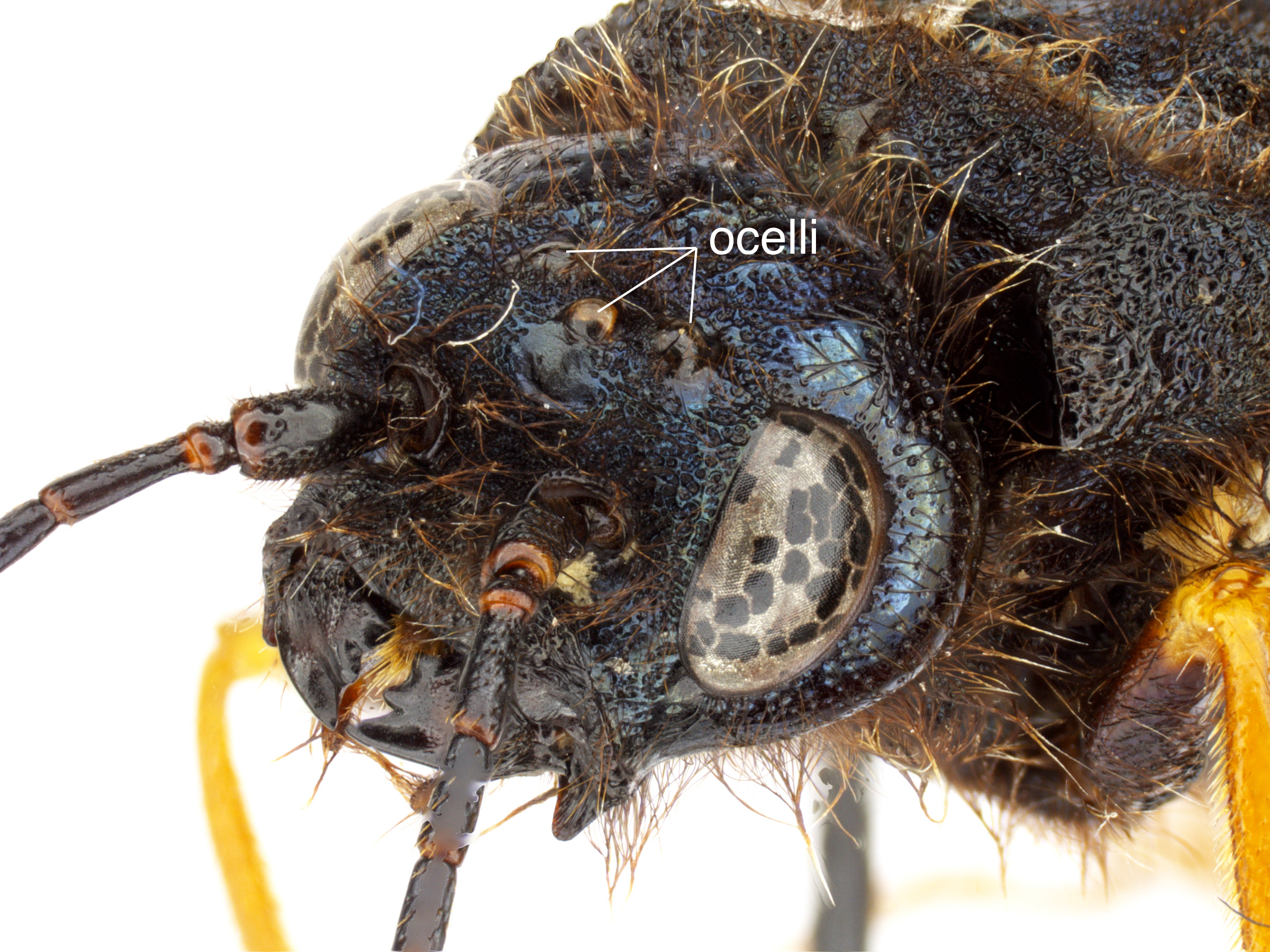Family: Tenthredinidae
Family common name: common sawflies
Subfamily: Allantinae
Tribe: Eriocampini
Genus: Eriocampa Hartig, 1837
Subgenera: none
The Tenthredinidae are the most species-rich family and are found throughout the world, in all continents but Antarctica. They are known as the “common sawflies.” They can generally be recognized by a cylindrical body and long, segmented antennaeantenna:
the sensory organ emerging from the front of the head, usually between the compound eyes and above the clypeus; includes the flagellum, scape and pedicel
 . Otherwise, they come in a variety of colors, sizes, and forms (Goulet 1992Goulet 1992:
. Otherwise, they come in a variety of colors, sizes, and forms (Goulet 1992Goulet 1992:
Goulet H. 1992. The genera and subgenera of the sawflies of Canada and Alaska: Hymenoptera. Symphyta. The insects and arachnids of Canada. Part 20. Agriculture Canada Publication.).
Sawflies in the Allantinae subfamily are mostly black and shining, sometimes with other colors. They have agricultural importance as some species are pests on cultivated and ornamental plants (Smith 1979aSmith 1979a:
Smith DR. 1979a. Nearctic sawflies. IV. Allantinae: Adults and larvae (Hymenoptera: Tenthredinidae). Technical Bulletin, U.S. Department of Agriculture 1595: 1-172.). They can be distinguished from other subfamilies by wing venationvenation:
the network of veins on a wing
(Smith 2003aSmith 2003a:
Smith DR. 2003a. A Synopsis of the sawflies (Hymenoptera: Symphyta) of America south of the United States: Tenthredinidae (Allantinae). Journal of Hymenoptera Research 12 (1): 148-192.).
Eriocampa are relatively large, about 6–9 mm in length, and fairly robust. All North American species are mostly black and have short antennaeantenna:
the sensory organ emerging from the front of the head, usually between the compound eyes and above the clypeus; includes the flagellum, scape and pedicel
 (Smith 1979aSmith 1979a:
(Smith 1979aSmith 1979a:
Smith DR. 1979a. Nearctic sawflies. IV. Allantinae: Adults and larvae (Hymenoptera: Tenthredinidae). Technical Bulletin, U.S. Department of Agriculture 1595: 1-172.).
There are 28 described species worldwide. Three species occur in North America, two of which are introduced from Europe/West Asia (Taeger et al. 2010Taeger et al. 2010:
Taeger A, Blank SM, and Liston AD. 2010. World Catalog of Symphyta (Hymenoptera). Zootaxa 2580: 1-1064.).
A NearcticNearctic:
describing the region of the Northern Hemisphere that includes North America south through northern Mexico
 key to species is included in Smith 1979aSmith 1979a:
key to species is included in Smith 1979aSmith 1979a:
Smith DR. 1979a. Nearctic sawflies. IV. Allantinae: Adults and larvae (Hymenoptera: Tenthredinidae). Technical Bulletin, U.S. Department of Agriculture 1595: 1-172..
Subfamily characters
 vein M and 1m-cu parallel (Smith 1979aSmith 1979a:
vein M and 1m-cu parallel (Smith 1979aSmith 1979a: vein 2A+3A complete, connected to 1A by crossveincrossvein:
vein 2A+3A complete, connected to 1A by crossveincrossvein:Genus characters
 , and mesoscutellummesoscutellum:
, and mesoscutellummesoscutellum: (Smith 1979aSmith 1979a:
(Smith 1979aSmith 1979a: notched (Smith 1979aSmith 1979a:
notched (Smith 1979aSmith 1979a: (Smith 1979aSmith 1979a:
(Smith 1979aSmith 1979a: vein 2r present (Smith 1979aSmith 1979a:
vein 2r present (Smith 1979aSmith 1979a: vein M intersecting Sc+R closely basalbasal:
vein M intersecting Sc+R closely basalbasal: peripheral veinvein:
peripheral veinvein: (Smith 1979aSmith 1979a:
(Smith 1979aSmith 1979a:Eriocampa can be confused with similar species in the subfamily Allantinae or tribe Eriocampini. It is most easily recognized by the circular carinacarina:
a ridge or raised edge
 forming a ring around the ocellusocellus:
forming a ring around the ocellusocellus:
a simple bead-like eye, often on the dorsum of the head in groups of 1-3
 (Smith 1979aSmith 1979a:
(Smith 1979aSmith 1979a:
Smith DR. 1979a. Nearctic sawflies. IV. Allantinae: Adults and larvae (Hymenoptera: Tenthredinidae). Technical Bulletin, U.S. Department of Agriculture 1595: 1-172.).
none
In North America, Eriocampa feeds on Juglans nigra (black walnut), Alnus rubra (red alder), A. incana (speckled alder) and A. glutinosa (black alder). In Europe, E. ovata is also recorded on Ulmus (elm) and Corylus (hazel) (Smith 1979aSmith 1979a:
Smith DR. 1979a. Nearctic sawflies. IV. Allantinae: Adults and larvae (Hymenoptera: Tenthredinidae). Technical Bulletin, U.S. Department of Agriculture 1595: 1-172.).
The female Eriocampa lays an egg into the midrib of the leaf. After hatching, the larvaelarva:
the immature stage of holometabolous insects
 feed externally on the leaves. LarvaeLarva:
feed externally on the leaves. LarvaeLarva:
the immature stage of holometabolous insects
 are known to secrete a white substance in long trails while feeding, which appears similar to bird fecal matter on the foliage. At maturity they drop to the ground and spin a cocoon in leaf matter at the basebase:
are known to secrete a white substance in long trails while feeding, which appears similar to bird fecal matter on the foliage. At maturity they drop to the ground and spin a cocoon in leaf matter at the basebase:
the beginning or most proximal area of any structure
of the plant (Mackay and Wellington 1977Mackay and Wellington 1977:
Mackay PA and Wellington WG. 1977. Notes on the life history and habits of the red-backed sawfly, Eriocampa ovata (Hymenoptera: Tenthredinidae). The Canadian Entomologist 109 (1): 53-58., Smith 1979aSmith 1979a:
Smith DR. 1979a. Nearctic sawflies. IV. Allantinae: Adults and larvae (Hymenoptera: Tenthredinidae). Technical Bulletin, U.S. Department of Agriculture 1595: 1-172.).
Eriocampa ovata in North America is parthenogeneticparthenogenesis:
a type of sexual reproduction where embryos are produced from unfertilized eggs
, and males are not known. It has a bivoltinebivoltine:
describing a life cycle with two generations per calendar year
life cycle (Smith 1979aSmith 1979a:
Smith DR. 1979a. Nearctic sawflies. IV. Allantinae: Adults and larvae (Hymenoptera: Tenthredinidae). Technical Bulletin, U.S. Department of Agriculture 1595: 1-172.). LarvaeLarva:
the immature stage of holometabolous insects
 mature through 6–7 instars (Mackay and Wellington 1977Mackay and Wellington 1977:
mature through 6–7 instars (Mackay and Wellington 1977Mackay and Wellington 1977:
Mackay PA and Wellington WG. 1977. Notes on the life history and habits of the red-backed sawfly, Eriocampa ovata (Hymenoptera: Tenthredinidae). The Canadian Entomologist 109 (1): 53-58.).
World: This genus is widespread in Europe (Liston 1995Liston 1995:
Liston AD. 1995. Compendium of European sawflies. list of species, modern nomenclature, distribution, foodplants, identification literature. Chalastos Forestry, Gottfrieding pp. 1-190.) and occurs in China and Taiwan (Wei et al. 2006Wei et al. 2006:
Wei M, Nie H, and Taeger A. 2006. Sawflies (Hymenoptera: Symphyta) of Chinamdash;checklist and review of research. Pp. 505-574. In: Blank SM, Schmidt S, and Taeger A, eds. Recent sawfly research mdash; synthesis and prospects. Goecke amp; Evers, Keltern., Haris 2015Haris 2015:
Haris A. 2015. Sawflies from China (Hymenoptera: Tenthredinidae). Natura Somogyiensis 26: 79-94.).
North America: Eriocampa juglandis is common in the eastern half of the United States north into Ontario. Eriocampa ovata was introduced to the Northeast and Northwest, possibly independently, and now ranges in New England and the Great Lakes area as well as in Washington, British Columbia, and Alaska (Smith 1979aSmith 1979a:
Smith DR. 1979a. Nearctic sawflies. IV. Allantinae: Adults and larvae (Hymenoptera: Tenthredinidae). Technical Bulletin, U.S. Department of Agriculture 1595: 1-172., Discover Life 2019Discover Life 2019:
Discover Life. Accessed January 2019. https://www.discoverlife.org).
Map data from: GBIF.org (29 October 2019) GBIF Occurrence Download Eriocampa
Details about data used for maps can be found here.